Metroid Game-by-Game Reviews: Metroid: Other M
Never meet your heroes... or your heroines.
This article first appeared on USgamer, a partner publication of VG247. Some content, such as this article, has been migrated to VG247 for posterity after USgamer's closure - but it has not been edited or further vetted by the VG247 team.
Japanese game development hit a rough patch soon after the arrival of high-definition consoles. For various reasons, Western studios turned out to be better poised to deal with the realities of a more technically taxing game console. Even the hardware itself reversed decades of Japan-vs.-America balance, with the Xbox 360 coming out of the gate strong in 2005; the revered PlayStation family's third entry took years to catch up after an abysmal false start.
And then you had Nintendo. Nintendo side-stepped the whole mess entirely by defiantly not going high-def. The company girded itself to do battle with its competitors' bold dives into HD technology by remaining contentedly in the graphical kiddie pool. The Wii shouldn't have worked, with its underpowered processor and a graphics chip capable of nothing better than EDTV resolution. Yet consumers flocked to its intuitive interface, reasonable price, and engrossing software made by developers who could afford to produce games on smaller budgets and therefore take creative risks that were quickly proving impossible on other consoles.
The Wii represented a brilliant example of a company finding success by paving its own road. For a while, Nintendo appeared unstoppable, as their puny Davids—the Wii and the DS—raced sales circles around the competition's Goliaths. Of course, we ultimately would see that Nintendo didn't so much side-step the rough transition into HD gaming so much as delay their own growing pains a generation. The Wii U would force Nintendo to deal with that bumpy upgrade in due time and prove the company no less fallible than its peers. In hindsight, we should have seen Metroid: Other M as the writing on the wall.
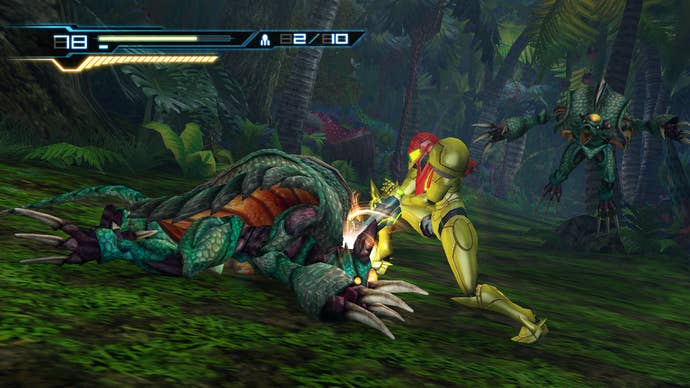
Has any Nintendo first-party creation experienced such a radical plummet from hotly anticipated announcement to reviled castaway as Other M? When Nintendo announced it at E3 2009, back in the days when they did the same full-scale E3 press conferences as their competition, you could feel the electricity in that stadium full of fans and press. The Prime games had been great, but Metroid hadn't seen a proper new entry in seven years; by the time Other M launched, Metroid Fusion was eight years old—the same age that Super Metroid had been when Fusion shipped. It was more than time.
Ask a Metroid fan about Other M now, however, and you'll have trouble finding even a hint of enthusiasm. The game has its fans, but they're few and far between. By and large, Other M went from giddy anticipation to uneven reviews to collective fan revulsion in short order. Time hasn't been kind to the game, and it's yet to experience any sort of critical rejuvenation or revised fandom upgrade to ragged-cult-classic status. Other M, quite simply, is the least-loved game in the Metroid canon... or it was until Nintendo announced Federation Force, anyway.
The kicker? Other M actually isn't a bad game at all. On the contrary, it turned out to be a pretty solid action game, with an emphasis on quick reflexes and brief, intense sessions of combat. The problem, then, is that while Other M succeeds as a pure action game, it's more or less garbage at being a Metroid game. It goes through the motions of grafting an approximation of the Metroid template onto a nimble reflex-oriented melee combat game, but at every turn it betrays an utter failure by its creators—including Metroid and Super Metroid designer Yoshio Sakamoto—to understand what part of the Metroid experience fans actually respond to.
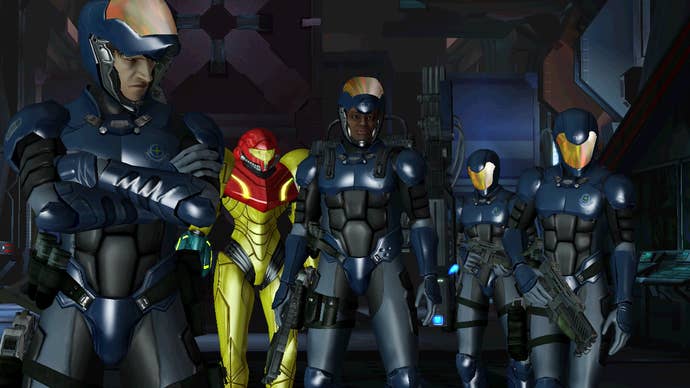
Here is a Metroid game in which progression doesn't revolve around Samus Aran's steady empowerment. The series' tradition had always been to drop Samus into a situation, underarmed and underpowered, to allow players to acquire the weapons and skills necessary not only to take on the bad guys but also to unlock the environments around her. Yet in Other M, Samus has most of her skills available from the beginning. Somehow, though, you can't go anywhere you like whenever you choose; the game still has a traditional, Metroid-like flow in that most areas remain inaccessible to you. This time, however, the freedom to move forward only becomes available once Samus is given permission to do so.
As part of a wildly misguided attempt to reveal the history behind Samus' interaction with the computer intelligence Adam in Metroid Fusion, Other M attempts to showcase Samus's history with the real Adam Malkovich. Here, he acts as her commander as she accompanies a Galactic Federation space marine squad as a sort of private military contractor. Much of the game world—another space station full of simulated environments, like the one in Fusion—remains closed to Samus and to player not because the tools to move into them remain undiscovered but simply because Adam hasn't yet given Samus clearance to activate those tools. You literally spend most of Other M handicapped because of the story's arbitrary rules. You can even wander into superheated zones before you're allowed to activate your heat-resistant suit upgrade; Adam will let you die rather than turn it on. Because, after all, being an effective commander means letting a mission-critical asset die rather than lift a rule before such time as the plot requires it.
In other words, Other M takes the least-loved aspects of Fusion and doubles down on them. The greatest complaints about Fusion among Metroid fans have always concerned the artifice of its structure and the hard boundaries enforced by the Adam A.I. At times you almost feel like Other M was an attempt by Sakamoto to prove that Fusion's design was in fact great and wonderful, doubters be damned.
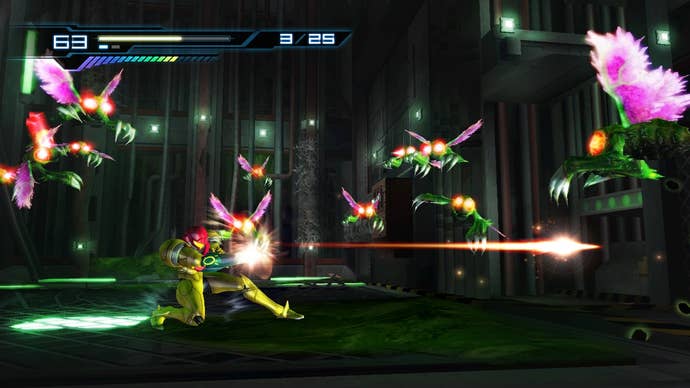
In practice, it comes off as a terrible misreading of everything that made Super Metroid great. Other M carries forward the general chain of progression as in previous Metroid games, as Adam allows Samus to unlock her usual set of skills as the situation demands, but otherwise this adventure feels nothing like its vaunted predecessor. Super Metroid left players alone to unravel the mystery of Zebes, steadily empowering them with new skills and options as they advanced.
Other M strong-arms you and scolds you for daring to stray from the mandatory path. Fusion did the same, but at least there its oppressive design served a ludo-narrative role: You were meant to feel helpless like Samus, so that once she restored her complete set of skills you could better appreciate her return to full power. Other M lacks any such metatext. You simply don't get to use your full array of powers because, well, that wouldn't fit the story.
And what a miserable story it is. The combination of the space station's gated, artificial environment with Adam's habit of barking orders at you gives Other M the distinct sensation of having been made of warmed over Fusion ideas—a notion reinforced by the eventual discovery that the Federation has not-so-shockingly engaged in a secret cloning program to study and harness the powers of the less-extinct-than-believed metroid species. Other M's story positions it as an interquel between Super Metroid and Metroid Fusion, and its recycling of the latter game's elements diminishes Fusion in retrospect by making its setting and plot redundant.
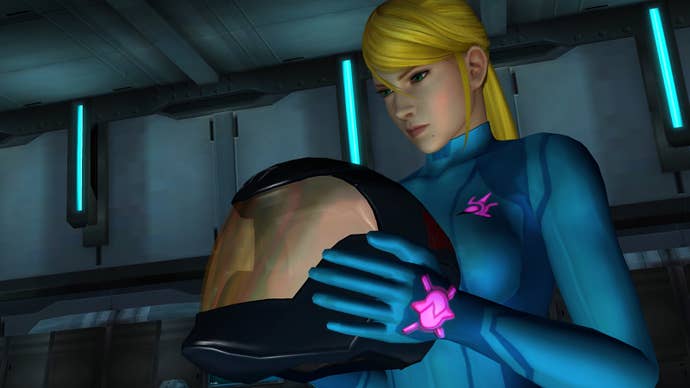
But far worse than that is what Other M does to Samus herself. Fusion weakened her physically, stripping away her powers and enfeebling her stamina and resistances. Other M weakens her as a person, as a character. There were promises before launch of the story revealing her "rich inner life," but in practice we see Samus reduced from a flinty, unstoppable juggernaut to a snotty child who cringes at the sight of a villain she's battled countless times before. Other M reveals more of Samus both through her present actions and via flashbacks to her days before becoming a bounty hunter, and neither paint her in a favorable, heroic, or interesting light.
It doesn't help that the plot Samus navigates here is a labyrinth of nonsense, involving a clone of Ridley and a secret simulated recreation of Mother Brain, both created by the Federation itself. Where early Metroid adventures felt like one woman's desperate fight for the fate of the galaxy, Other M casts players into the role of a meek tagalong for someone's else clean-up efforts prompted by a string of idiotic decisions by the government. It's not exactly inspiring stuff, and at every turn it serves to diminish Samus.
Other M manages to get only one thing right: Samus's combat skills. Nintendo roped in Koei's Team Ninja to infuse Other M with the sort of brisk, challenging combat mechanics that had made the Ninja Gaiden reboots such fan-favorites on Xbox. The game avoids continuing the series' tradition of 2D action games and first-person shooting in favor of 3D combat arenas viewed from fixed camera angles, with an emphasis on in-close combat that fluidly shifts between gunplay and melee strikes. The overall structure of conflict encounters honestly doesn't stray too far from Metroid's heritage, but the shift in the third-person viewpoint to a more top-down perspective changes the feel of the action considerably.
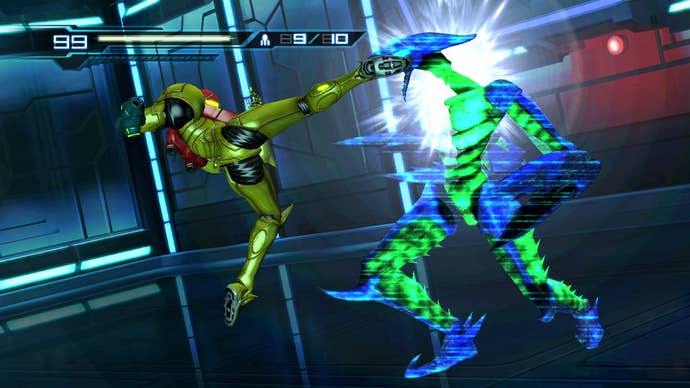
Perhaps not surprisingly, given Team Ninja's roots in Dead or Alive and Ninja Gaiden, Other M's battle mechanics place heavy emphasis on parries, counters, and reversals. Samus has to be light on her feet here, since enemies hit fairly hard; rather than soaking up damage as in other Metroid games, you instead use a "quick step" dodge button to evade foes and bide your time until you spot an opening. It's a fast, visceral take on the series that feels distinct, but nevertheless feels more faithful to 2D Metroid action than Metroid Prime's immersive combat.
Unfortunately, the clever combat mechanics can't make up for all the other ways Other M badly misses the point of Metroid. On the contrary, for all the battle design's moment-to-moment thrills, it ultimately undermines the overall workings of Metroid as well: The switch to a high overhead camera viewpoint greatly diminishes the exploratory element of the series. There's less opportunity to roam freely, to slip between cracks, to find hidden seams in the world. Discovery here is more likely to take the form of slow, zoomed-in, non-combat walking sequences. Or worse, to play out as point-and-click first-person scenes that force you to perform blind pixel hunts, often while racing a timer (failure amounts to a game over). What in the world were they thinking?
Well, I know what they were thinking: Other M represents Nintendo's first real effort to embrace the evolving shape of action games in the HD era. The rise of new-style third-person action games like Assassin's Creed and Uncharted, coupled with the struggles of Japanese studios and their more traditional RPGs and action games, spoke to a massive sea change in the medium and its audience. Nintendo tried to tackle this shift head-on by teaming up with a Japanese developer whose work had found its greatest success in the U.S., asking them to reinvent a long-running series whose most enthusiastic audience had always been Americans. On paper, the thought of Team Ninja tackling Metroid sounded like a sure win. Something went wrong along the way, though, and the end result was a far cry from anything Metroid fans could have wanted. Rather than rejuvenating the franchise, Other M nearly killed it.
ConclusionWhile not a bad game in its own right, Other M is terrible at being Metroid. The slick combat system plays well but feels out of place in a Metroid game, while the story, pacing, and gating utterly miss the point of what Metroid has always been. Thank goodness for Samus Returns, or else this would stand as the final official statement on Samus Aran's adventures.








